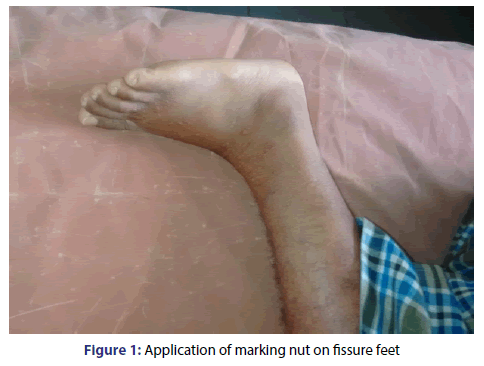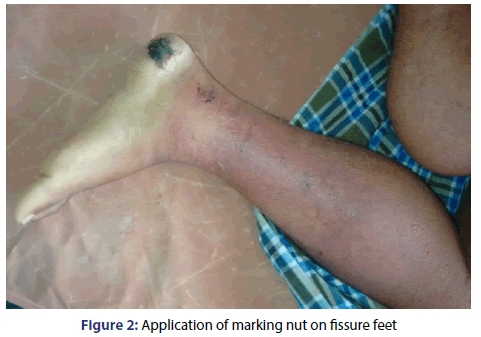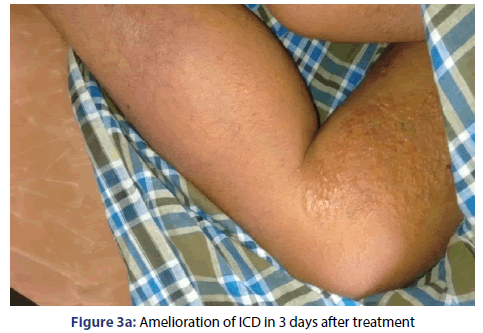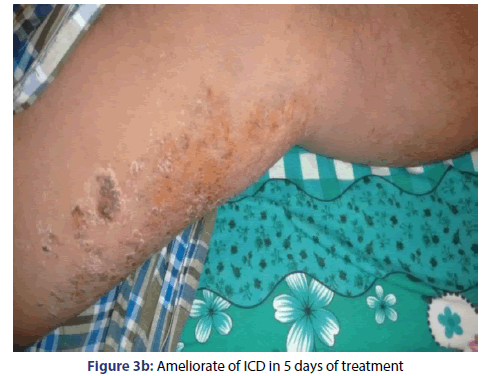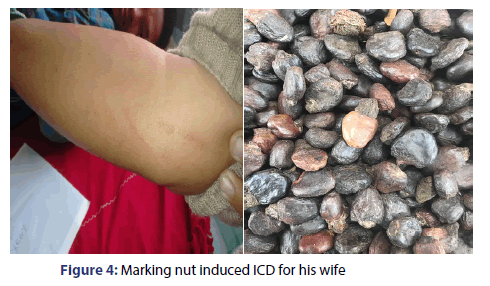A Case Report on Semecarpus anacardium Induced Extensive Irritant Contact Dermatitis
Citation: Sateesh Kumar Reddy K, Ushasree P, Shanmuga Kumar SD, Vijay Raghavendra NC, Faheemuddin MD. As Case Report on Semecarpus anacardium Induced Extensive Irritant Contact Dermatitis. J Basic Clin Pharma 2018;9:106-108.
This open-access article is distributed under the terms of the Creative Commons Attribution Non-Commercial License (CC BY-NC) (http://creativecommons.org/licenses/by-nc/4.0/), which permits reuse, distribution and reproduction of the article, provided that the original work is properly cited and the reuse is restricted to noncommercial purposes. For commercial reuse, contact reprints@jbclinpharm.org
Abstract
Semecarpus anacardium is otherwise known as marking nut which has unsung medical properties. It has been claimed as half physician in Ayurveda. The folklore claims states that Semecarpus anacardium possess medicinal properties like anti carcinogenic, anti-inflammatory, antioxidant, hypoglycemic, antimicrobial and contraceptive properties. In contrary to its biological potentials it has an adverse reaction like contact dermatitis. In this present study, a case of a couple which had got admitted in the hospital with the signs and symptoms of irritant contact dermatitis, after treating the fissure feet with the marking nut. Initially the case has been extensively treated with azithromycin and levocetirizine and the patient’s condition became worsen with the given medication. Due to the severity of the disease, the patients were been taken care under a tertiary care hospital in a dermatological sequences and they were been treated with antihistamines, antibiotics, for a period of 5 days. The patients were responded to the treatment and been recovered from the severe dermatitis and they have been discharged after the completion of treatment.
Keywords
Semecarpus anacardium; contact dermatitis; adverse effect; ceftriaxone
Introduction
Semecarpus anacardium is commonly known as marking nut which contains a pigment that has been used to mark fabrics.[1] This plant consists of anti-inflammatory, antiarthritic, antioxidant, antimicrobial and also anticarcinogenic perspectives pertaining to liver, esophagus, and urinary bladder. The major adverse reaction of Semecarpus anacardium is contact dermatitis.[2] Contact dermatitis refers to the skin inflammation that is occurring as a result of exposure of irritants or allergens. Irritant contact dermatitis (ICD) is a localized inflammatory reaction which occurs due to the contact of chemical/ physical agent which causes cytotoxic skin damage which leads to skin barrier disruption, cellular changes and release of pro inflammatory mediators. On contrary, allergic contact dermatitis is a delayed type of hypersensitivity reaction mediated by T-cells. Irritant contact dermatitis is usually caused by frequent and repeated use of known irritating substances, such as soap water, cleansers, rubbing alcohol, rubbers, coolants, nickel, petrolactum, chemicals (phenols aldehydes, and methanol etc.), resins, acrylics, paper friction, and fiberglass etc.[3] Most common clinical manifestations of ICD are inflammation of skin, itchiness, red skin, rash, swelling, painful skin lesions. In a study it was observed that females preponderance to contact dermatitis than males. [4] In the present study, an observation has been made of a couple who were suffered with irritant contact dermatitis due to the utilization of marking nut for healing fissure foot. A 32 years old male and 30 years old female patients presented to have fissure feet and had been treated by utilizing the fruit extract of marking nut (Semecarpus anacardium). Within an hour of applying the fruit extract to the fissure feet the male patient observed a severe itching in the hip region of the right leg with erythematous vesicles and painful rashes [Figures 1-4]. In similar lines, his wife (30 years old) were also been affected. The patients were been treated initially with the dose of azithromycin 500 mg, and levocetirizine and hydroxy hydrochloride. After a few intervals of the treatment the disease has been noticed to become worsen. Later they got admitted in a tertiary care hospital with the complaints of multiple vesicles over the skin, maculopapular rashes over the forearm, inner thighs and entire chest region. Further they were been presenting a compliant of blisters scaly itching, erythematous skin rashes, swelling and burning sensation over the thigh of both legs. Further it was observed that an edema has been formed over the face and feet. Initial measure is to withdraw the use of azithromycin, which is an inducing factor for dermatitis.[5] Social history of patient shows that the male patient a chronic alcoholic for 6 years. Lab investigations were been performed associated with clinical investigations. It was found that blood pressure, pulse rate were normal and temperature was in febrile condition. Complete blood picture shows normal levels of haemoglobin-14.8 gm/dL, WBC levels were increased to 16500 cells/cumm which signifies the presence of inflammation. Liver function tests shows increased levels of total bilirubin to 2.5 mg/dL and direct bilirubin to 0.5 mg/dL for which he was diagnosed with hepatomegaly and he is undergoing treatment with ursodeoxycholic acid-300 mg OD. Tzank test was done to confirm whether the patient has been affected by herpes simplex infection and found to be negative. Patch test was done which shows the patient was irritant to marking nut. In similar lines, female patient was subjected to clinical and lab investigations. Based on the data obtained Patient has been treated with the following medications for 5 days Inj. Pheniramine maleate-2 cc IM, B.D, Dexamethasone-2 cc IM, B.D, Tab. Mahacef XL [cefixime-200 mg, dicloxacillin-500 mg, lactobacillus-90 million cells], Tab. Lyser-D [serratiopeptidase-10 mg, diclofenac-50 mg], Inj. Ceftriaxone-1 g BD, Calosoftlotion [calamine, aleovera, light liquid paraffin], Pantoprazole- 40 mg, Fucidic-BNF cream [fusidic acid-2% w/w, beclomethasone-0.02% w/w], Mupirocin-2% ointment BD, Tab. Ursodeoxycholic acid-300 mg OD. Then the patient was recovered from the characteristic features of irritant contact dermatitis. Except ursodeoxycholic acid the same medication was given to his wife who as the same clinical manifestations of the patient [Table 1].
| Internal Treatment | External Treatment | ||||||
|---|---|---|---|---|---|---|---|
| S.No | Medicines | Dose | Duration | Medicines | Dose | Duration | |
| 1. | Inj. Pheneramine Maleate- IM | 2cc | 5 days | Calosoft lotion | 5days | ||
| 2. | Dexamethasone | 2cc | 5 days | Fucidic – BNF cream | 5days | ||
| 3. | Tab. Lyser-D | 5days | Mupirocin ointment | 2% | 5days | ||
| 4. | Inj. Ceftriaxone | 1gm | 5days | ||||
| 5. | Tab. Pantoprazole | 40mg | 5days | ||||
| 6. | Tab. Ursodeoxycholic acid | 300 mg | 5days | ||||
| 7. | Tab. Mahacef-XL | 5days | |||||
Table 1: Internal and External Treaatment.
Discussion
Despite of many significant uses of marking nut there are some adverse reactions like contact dermatitis were been reported. This is due to the presence of a chemical constituent urushiol.[6] Complications of contact dermatitis include neurodermatitis, decreased quality of life, ooze fluids and crust. After treating with the prescribed medication for 5 days patient claims of attenuation of symptoms. Similar complaints were noticed by his wife and the same treatment was given to her of disease was noticed after 5 days and both of them got discharged. Urushiol is an oily organic compound with hypersensitive properties found in plants of the family anacardiaceae. Several cases have been reported with contact dermatitis when the patients were exposed to urushiol. Urushiol induced rashes are a type 4 hypersensitivity raction which is alsoknown as delayed type hypersensitivity which includes symptoms such as itching, inflammation, oozing and burning sensation. Urushiols are oxidized in-vivo generating a quinone form of the molecule. The adverse effect is indirect mediated by an induced immune reponse. They act as a haptens changing the shape of integral membrane protiens on exposed skin cells. Allergic contact dermatitis is a severe condition that can be caused by the various phytoconstituents and their derivatives.[7] Further, it was observed that severity after the administration of an antibiotic agent azithromycin which is idiopathic. Hence the people should be vigilant and acquire knowledge when they were subjected to the treatment of indigenous system of medicine.
REFERENCES
- Jie SF, Anita CK, John H, William BS. Marking nut anaphylaxis, Asia pacific allergy 2016;6:192-4.
- Poornima Mansoria, Sharma Anita, Gothecha vinod kumar. Semecarpus Anacardium 2013;6:70-3.
- Cheryl LE. Irritant contact dermatitis: Mechanisms to Repair 2014;5:1-8.
- Kailash B. Allergic contact dermatitis by semecarpus anacardium for evil eye: A prospective study from central India 2014;3:122-7.
- Indranil Banerjee, Somnath Mondal, Sukanta sen. Azithromycin-Induced Rash in a patient of infectious mononucleosis-A case report with Review of literature 2014;8:173-9.
- Rangasamy I, Rabinarayan A, Roshy JC. Urushiol-Induced contact dermatitis caused during shodhana (purificatory measures) of Bhallataka (semecarpus anacardium linn.) fruit 2012;33:270-3.
- Frad JE, Richard JS. Plant and plant product that induced contact dermatitis, Journal of medicinal plant research 1980;38:289-316.


